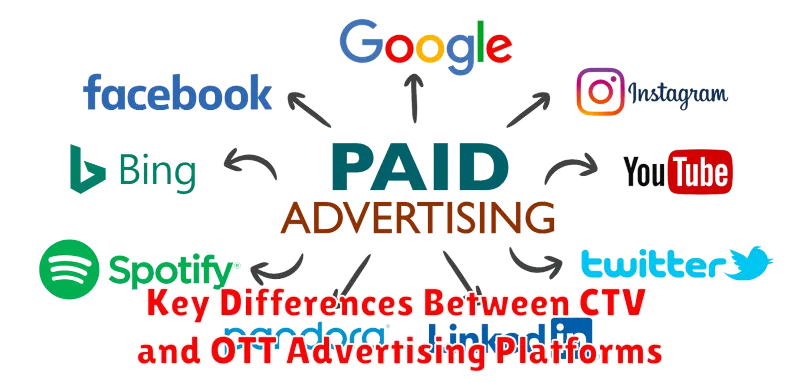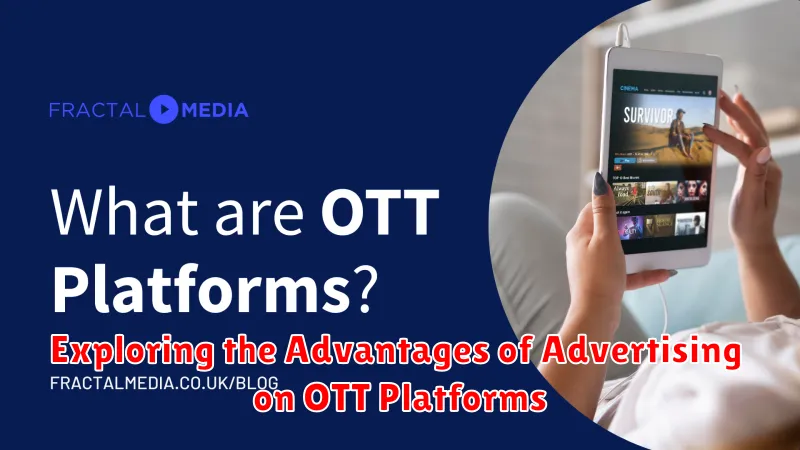In the rapidly evolving landscape of digital advertising, understanding the nuances between different video advertising channels is crucial for marketers. This article delves into two prominent terms: Connected TV (CTV) and Over-the-Top (OTT). While often used interchangeably, there are key distinctions that impact advertising strategies and campaign effectiveness. We will explore the fundamental differences between these platforms, providing a comprehensive overview for advertisers seeking to leverage the power of video marketing.
The global CTV market is experiencing exponential growth, fueled by the increasing adoption of smart TVs and streaming devices. OTT platforms, delivering content directly to consumers via the internet, are revolutionizing the way audiences consume media. This creates significant opportunities for advertisers to reach engaged viewers with targeted and measurable campaigns. This article will equip you with the knowledge to navigate the CTV vs OTT landscape and make informed decisions about your digital advertising investments. Understanding these platforms allows you to tap into a growing market of engaged viewers, ultimately driving better results for your video advertising campaigns.
Defining CTV (Connected TV): What It Is and How It Works
Connected TV (CTV) refers to televisions that can be connected to the internet and access video content beyond traditional broadcast or cable channels. This connection enables users to stream content directly onto their television sets.
How CTV Works: CTVs connect to the internet via Wi-Fi or Ethernet. This connection allows devices to access streaming services and apps, such as Netflix, Hulu, and YouTube. These services deliver video content directly to the TV without requiring a cable box or satellite receiver.
Key Components:
- Smart TVs: Televisions with built-in internet connectivity and streaming capabilities.
- Streaming Devices: External devices like Roku, Amazon Fire TV, and Apple TV that connect to a TV to enable streaming.
- Gaming Consoles: Devices such as PlayStation and Xbox, which offer streaming apps alongside gaming functionalities.
CTV provides a platform for advertisers to reach viewers in a more targeted and measurable way compared to traditional TV advertising.
Defining OTT (Over-the-Top): What It Is and How It Works
Over-the-Top (OTT) refers to content delivered via the internet, bypassing traditional distribution methods like cable or satellite TV. It encompasses a wide array of video and audio services accessible directly to consumers.
Fundamentally, OTT relies on an internet connection to stream content to various devices. This includes:
- Smart TVs
- Streaming devices (e.g., Roku, Amazon Fire TV, Apple TV)
- Computers
- Mobile devices (smartphones, tablets)
OTT services often operate on a subscription basis (e.g., Netflix, Hulu) or offer ad-supported models (e.g., YouTube, Tubi). Some providers also utilize transactional video-on-demand (TVOD) for individual purchases or rentals.
How it Works: OTT content is delivered through a network of servers directly to the user’s device. Users access the content through dedicated apps or web browsers. The streaming quality is typically adaptive, adjusting based on the user’s internet connection speed to ensure smooth playback.
Key Differences Between CTV and OTT Advertising Platforms

While often used interchangeably, CTV (Connected TV) and OTT (Over-the-Top) advertising platforms have distinct characteristics. Understanding these differences is crucial for effective ad campaign planning.
CTV refers to the hardware used to stream content, such as smart TVs, Roku devices, Apple TVs, and gaming consoles. Advertising on CTV is typically associated with ads served directly within the TV environment. Ads can be pre-roll, mid-roll, or banner ads within apps.
OTT, on the other hand, refers to the method of content delivery – streaming video content directly to viewers over the internet, bypassing traditional cable or broadcast providers. OTT advertising focuses on the delivery method. It is a broader term, encompassing CTV advertising, as well as ads served on mobile devices, computers, and other internet-connected devices.
In essence, CTV is a subset of OTT. Therefore, when choosing between these two platforms, consider your target audience, desired reach, and campaign goals. CTV provides focused delivery within the TV environment, while OTT offers a broader reach across various devices.
Understanding the Benefits of Advertising on CTV
Advertising on Connected TV (CTV) offers several key advantages for marketers looking to reach a highly engaged audience. One of the primary benefits is the ability to target viewers with precision. CTV advertising allows for advanced demographic and behavioral targeting, ensuring that your ads are seen by the most relevant audience segments.
Furthermore, CTV provides a premium viewing experience. Ads are typically displayed in a full-screen, non-skippable format, capturing the viewer’s undivided attention. This results in higher brand recall and engagement rates compared to traditional television advertising.
Enhanced measurement capabilities are another significant benefit. CTV platforms offer detailed analytics, allowing advertisers to track key performance indicators (KPIs) such as impressions, completion rates, and conversions. This data-driven approach enables marketers to optimize their campaigns for maximum effectiveness and return on investment (ROI).
In summary, CTV advertising combines the reach of television with the precision of digital, making it a powerful tool for building brand awareness and driving conversions.
Exploring the Advantages of Advertising on OTT Platforms

Over-the-Top (OTT) advertising presents distinct advantages for brands seeking to connect with specific audiences in targeted environments. These benefits stem from the unique nature of how viewers consume content on OTT platforms.
One key advantage is granular targeting. OTT platforms allow advertisers to leverage demographic, interest-based, and behavioral data to ensure ads are displayed to viewers most likely to be receptive to the message.
OTT advertising also offers improved brand safety. Ads are typically shown within premium, professionally produced content, mitigating the risk of association with inappropriate or harmful environments. This enhances brand reputation and credibility.
Furthermore, OTT advertising provides enhanced engagement opportunities. The longer-form content consumption environment on OTT leads to greater viewer attention, allowing for more impactful ad experiences compared to shorter-form video platforms. This increased attention span can translate into higher brand recall and improved conversion rates.
Targeting Options Available on CTV and OTT Advertising
CTV (Connected TV) and OTT (Over-the-Top) advertising offer robust targeting capabilities, allowing advertisers to reach specific audiences with greater precision. The platforms utilize various data points to refine ad delivery.
CTV Targeting Options
CTV platforms often leverage data from device registration, viewership history, and integrations with third-party data providers. Common targeting options include:
- Demographic Targeting: Age, gender, income, and education level.
- Geographic Targeting: Country, region, city, and zip code.
- Behavioral Targeting: Interests, hobbies, and purchasing habits.
- Contextual Targeting: Based on the content being watched (e.g., sports, news, movies).
- Device Targeting: Specific connected TV devices or brands.
OTT Targeting Options
OTT platforms offer similar targeting options, often enhanced by user profile data within their respective ecosystems. These include:
- First-Party Data Targeting: Leverage data collected directly from users of the OTT service.
- Interest-Based Targeting: Reach users based on their viewing preferences and interests within the OTT platform.
Measurement and Analytics in CTV and OTT Advertising
Measurement and analytics are critical for evaluating the success of CTV and OTT advertising campaigns. Unlike traditional television advertising, CTV and OTT offer sophisticated tracking capabilities, providing advertisers with valuable insights into campaign performance.
Key metrics to monitor include:
- Completion Rate: The percentage of viewers who watch the entire ad.
- Click-Through Rate (CTR): The ratio of users who click on an ad to the number of times the ad is shown.
- Reach and Frequency: The number of unique viewers reached and the average number of times they were exposed to the ad.
- Viewability: Measures whether an ad was actually seen by a viewer.
- Attribution: Connecting ad exposure to desired outcomes, such as website visits or purchases.
Advanced analytics platforms can provide more granular data, such as demographic information, viewing habits, and engagement metrics. This data allows advertisers to optimize their campaigns in real-time, improve targeting, and maximize ROI.
Best Practices for Creating Effective CTV and OTT Ad Campaigns
Crafting successful CTV and OTT advertising campaigns requires a strategic approach. Start by defining clear campaign goals and target audiences.
Key Strategies for Success
- Prioritize High-Quality Creative: Invest in visually appealing and engaging video ads.
- Keep it Concise: Respect the viewer’s time with shorter, impactful ads. Aim for 15-30 second spots.
- Optimize for Sound-On Environments: Design ads that are effective with and without audio.
- Utilize Frequency Capping: Prevent ad fatigue by limiting the number of times a viewer sees the same ad.
- Implement Robust Tracking and Analytics: Monitor campaign performance closely to make data-driven optimizations.
- Ensure Brand Safety: Partner with reputable platforms to avoid appearing alongside inappropriate content.
A/B test different creative elements and targeting parameters to identify what resonates best with your audience. Regularly review and refine your campaign strategy based on performance data to maximize your return on investment (ROI).
The Future of CTV and OTT Advertising: Trends to Watch
The landscape of CTV and OTT advertising is rapidly evolving, driven by technological advancements and shifting consumer behaviors. Several key trends are poised to shape the future of this dynamic space.
Increased Personalization: Expect more sophisticated data-driven targeting enabling advertisers to deliver highly personalized ad experiences to individual viewers. This includes leveraging contextual data and real-time analytics to optimize ad delivery.
Enhanced Measurement and Attribution: The industry is moving towards more robust measurement solutions that accurately track the impact of CTV and OTT campaigns across different devices and platforms. This will allow advertisers to better understand ROI and optimize their spending.
Rise of Interactive Advertising: Look for increased adoption of interactive ad formats that allow viewers to engage directly with ads, such as clickable buttons, polls, and quizzes. This fosters greater engagement and provides valuable user data.
Programmatic Advancements: Programmatic buying will become even more sophisticated, enabling advertisers to automate the process of buying and selling ad space, optimizing campaigns in real-time, and reaching specific audiences with greater efficiency.

